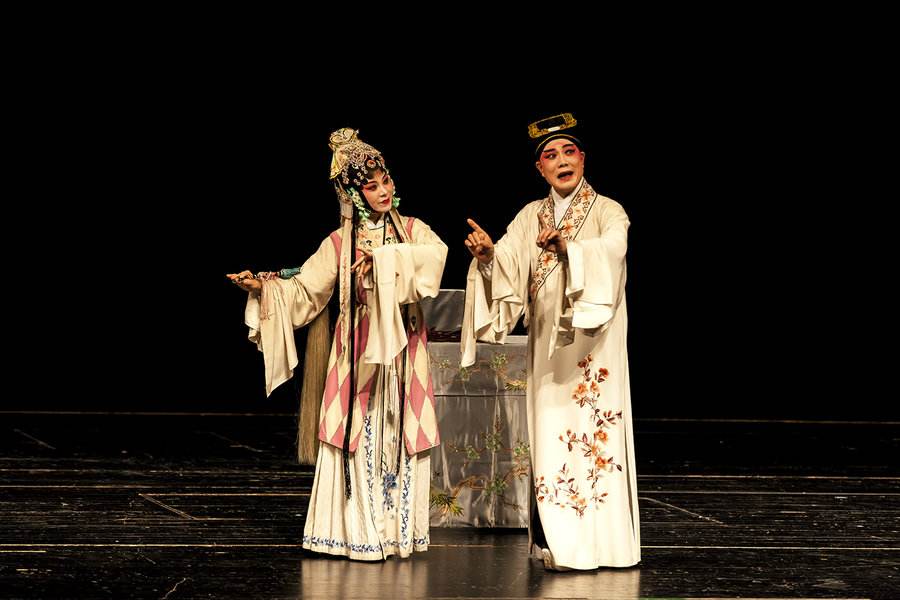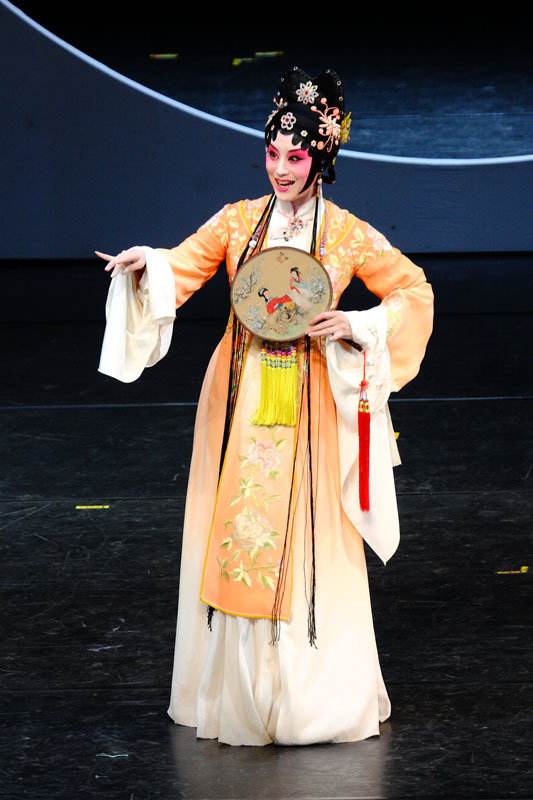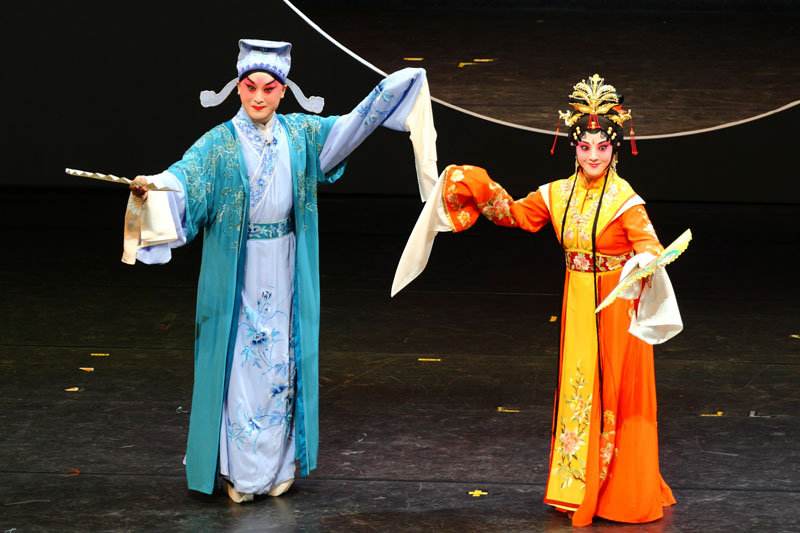Development and Maturation
11 min readFolk artists played a critical role in the early development of Kunqu opera. After Kunqu opera became established as a comprehensive dramatic art form, it entered a new stage of development and matura-tion. During this period, many renowned authors and scholars began to work in the genre, producing numerous scripts characterized by exquisite poetry and intricate plots. Ming Dynasty literary cir-cles gave rise to two masterpieces: Baojian Ji(Legend of a Sword), by Li Kaixian(1502-1568 AD), and Mingfeng Ji(Legend of the Phoenix), by Anonymous. These works were written during the same period as Liang Chenyu’s Huansha Ji(Washing the Silken Gauze), and were equally as influential. These works were later adapted as Kunqu operas, and became important pieces in the Kunqu canon.
Baojian Ji(Legend of a Sword) is based on the famous novel Shuihuzhuan(Water Margin). The author, Li Kaixian, was a famous mid-Ming Dynasty poet, scholar, and former court oficial. The story uses the background of the Song Dynasty to offer an oblique commentary on the political and social situation of the Ming Dynasty. It is artistically quite inspiring.

Lin Chong in Kunqu opera Baojiani:
Ye Ben(Legend of a Sword: Absconding by Night)
In comparison with Baojian Ji(Legend of a Sword), Mingfeng Ji(Legend of the Phoenix) is a relatively realistic expose of political corruption in the Ming Dynasty. Its material is directly taken from real life, telling the story of the heroic struggle between a group of upright officials, led by Yang Jisheng(1516-1555AD), and the evil prime minister Yan Song(1480-1567 AD) and his cohorts.Mingfeng Ji(Legend of the Phoenix) may be taken as an actual depiction of political life in 16th century China.
Huansha Ji(Washing the Silken Gauze), Baojian Ji(Legend of a Sword), and Mingfeng Ji(Legend of the Phoenix) all are concerned primarily with political issues. Another group of Kunqu operas may be clas-sified as love stories. They include Xiuru Ji(An Embroidered Robe) by Xu Lin(1462-1538 AD) and Yuzan Ji(The Jade Hairpin) by Gao Lian(dates of birth and death unknown). From this time on, politics andlove provided the two main themes of Kunqu operas. Sometimes they were addressed individually, and sometimes they were intimately linked.
Zheng Yuanhe and Zheng Dan in Kunqu opera
Xiuru Ji(An Embroidered Robe)
Xu Lin was an important mid-Ming Dynasty dramatist. His work Xiuru Ji(An Embroidered Robe) was frequently performed, and became a classic of the Kunqu canon.(See Appendix 1 for plot synopsis.)Set in common society, it is the love story of the young scholar Zheng Yuanhe, who has traveled to the capital to take the imperial examinations, and the prostitute Li Yaxian. The kindness and integrity of Li Yaxian serve as a foil for base human nature. This idealistic woman of the lower classes is shown to be both noble and endearing.

Yuzan Ji(The Jade Hairpin)by Gao Lian recounts the love story of Pan Bizheng,a young scholar,and Chen Miaochang,a Taoist nun.This innovative work vividly cap-tures the emotional upheaval of two young people head-over-heels in love.The plot’s many comic twists and turns distinguish it from the popular romances of the time,giving it a refreshing new perspective.
In real life,young people in classical China had virtually no opportunity for personal choice in love.
In particular,young women raised in cultured families had no say in the selection of their future hus bands.Their marriages were entirely arranged by the parents.Young men,on the other hand,were able to carry on love affairs with prostitutes.These relationships therefore became vital alternatives to marriage.As a result,prostitutes figure strongly in Kunqu opera.When the female protagonist is a young woman of the literati and bureaucracy,special circumstances,such as staying at a temple or fleeing from disaster,must be introduced.Only when the characters are able to escape the chains of social convention in this way is the flowering of love possible.This situation is clearly reflected in love stories such as Xiuru Ji(An Embroidered Robe)and Yuzan Ji(The Jade Hairpin).However,with the ap-pearance of Mudanting(The Peony Pavilion)by Tang Xianzu(1550-1616 AD),this convention was com-pletely broken.
Portrait of Tang Xianzu
Tang Xianzu was a great Ming Dynasty dramatist.He was fourteen years older than his contemporary,William Shakespeare(1564-1616 AD),and died the same year.Tang Xianzu’s great work Mudanting(The Peony Pavilion)boldly brought young women’s dreams of love to the stage,stirring up great con-troversy throughout society.At the same time that Shakespeare’s production of A Midsummer’s Night’s Dream was being played to rollicking laughter in Elizabethan London,Mudanting(The Peony Pavilion)was captivating audiences throughout China.It was the talk of the town from the luxurious homes of the upper class to the outdoor theaters of the common people.
Zaju opera performance;Yuan Dynasty(1271-1368AD)
Mudanting(The Peony Pavilion)is an enduring masterpiece of Kunqu opera.This love story,set in the Song Dynasty,serves as a vehicle to express the author’s humanist philosophy and advocacy of individual liberty.The depiction of the female protagonist,Du Lini-ang,was of immeasurable significance to Chinese literature and art.Not only does Du Liniang die for love,she is also reborn for love.Such passionate love was unknown in real life in classical China.TangXianzu’s romantic writing depicts the victory of love over death and over the chains of China’s feudal tradition.The entire work overflows with the author’s optimism and sense of humor.
Kunqu musical score,by Shen Jing Shen Jing(1553-1610 AD),of Wujiang,Jiangsu Province was another important Ming Dynasty drama-tist.Shen Jing was not a radical like Tang Xianzu,but he was equally influential in literary circles.
Shen Jing was relatively conventional and conservative in his attitudes,and fully supported the social system of the time.This outlook is clearly expressed in his Kunqu operas.Yixia Ji(Legend of the Swords-man)objectively portrays perversions of justice,including the depredations of evildoers,chaos in the judiciary,and bribery of officials.These social phenomena are seen to be concrete manifestations of ethical and moral decay.The mortal struggle between the valiant swordsman Wu Song and the forces of evil is extolled as righteous behavior.The moral of the story is that it is necessary to uphold the established social order,with the emperor at the center.Only then is it possible to restore social morality.From a production standpoint,Shen Jing’s Kunqu work places great importance on dramatic presentation.His operas provided his contemporaries,as well as future gen-erations of dramatists,with a lasting model of stagecraft technique.Shen Jing’s artistic vision inspired and influenced a group of local writers,giving rise to the Wujiang school of Kunqu opera.

Chen Miaochang(right),Taoist nun(third from left),Pan Bizheng(second from left),the servitor(left)in Kunqu opera Yuzan Ji(The Jade Hairpin)The emergence of great masters such as Tang Xianzu and masterpieces such as Mudanting(The Peony Pavilion),as well as the rise of influential regional genres such as the Wujiang school,marked the be-ginning of the golden age of Kunqu opera.Led by Tang Xianzu,Shen Jing,and others,Ming Dynasty Kunqu opera underwent a rapid process of maturation,producing numerous great achievements and a large body of classic works.Even a number of Yuan Dynasty(1271-1368 AD)dramas were adapted for performance as Kunqu operas.
Xiuxiang Huitu Mudanting Chuanqi(Scene from The Peony Pavilion),block print;
Ming Dynasty,Wanli reign period(1573-1620 AD)
During this period,Kunqu opera performances were concentrated in the Jiangsu,Anhui,and Zhejiang region.During the Wanli reign period(1573-1620 AD),many professional folk troupes were established to meet growing public demand.Kunqu folk troupes proliferated rapidly during the Tianqi(1621-1627AD)and Chongzhen(1628-1644 AD)reign periods of the Ming Dynasty.Several dozen troupes were ac-tive in the Nanjing area alone.
The practice of maintaining private opera troupes became quite fashionable among the literatiand gentry during the Ming Dynasty.These private troupes were even more numerous and active than the folk troupes that performed professionally.Vying to have the best private opera troupe was an extremely popular pastime among the Ming Dynasty bureaucracy.Prime ministers and high officials members of the imperial family and the nobility,all considered their private Kunqu troupes to be among their greatest glories.Members of the gentry maintained these private troupes primarily for artistic enjoyment or to dabble in theatrical production,rather than as commercial ventures.As a result, they were free to be quite experimental in terms of both content and technique. Most owners of private troupes were highly versed in all aspects of Kunqu opera.A number also worked behind the scenes, utilizing their extensive artistic background to write scripts, train performers, engage in stage design, and direct productions. These artists were instrumental in enriching every aspect of Kunqu opera. Private Kunqu troupes received extensive guidance from the writers and scholars who com-prised China’s literati, as well as substantial financial backing from the gentry. As a result, their pro-ductions were relatively polished, and their overall quality often far surpassed that of folk troupes.
Chinese opera master Mei Lanfang as Du Liniang in Mudanting (The Peony Pavilion);1930s In addition to folk and private Kunqu troupes, productions by amateur performers were an important aspect of Kunqu opera during the Ming Dynasty. Members of these groups included writers, scholars wealthy commoners, folk musicians, freelance professionals, and highly cultured courtesans.
Late in the Ming Dynasty, Kunqu opera entered the palace, where it was introduced as a new form of entertainment for the emperor. At the same time, it broke free of its regional bounds, becoming popular throughout northern as well as southern China. Kunqu finally was accepted at every level of Chinese society. This period saw the emergence of a large number of famous dramatists, as Kunqu opera reached its fully mature form. Writers, scholars, and folk performers alike dedicated themselves to perfecting their art, applying their abilities and talent to impel Kunqu opera to ever greater heights.
Du Liniang (left) and Liu Mengmei(right)
in youth performance of Mudanting(The Peony Pavilion); performance still from 2006 performance Thanks in part to the enthusiastic participation of the literati and gentry, both the creation and per-formance of Kunqu opera flourished during the Ming Dynasty, spreading rapidly throughout society.
From the ruling class in their palaces to the common people in the marketplaces, everyone was infatu-ated with the burgeoning new art form. The chief expression of Kunqu’s new status was the popularity of Kunqu opera arias. When an art form becomes beloved by an entire people, it no longer remains the sole province of a small circle of artists. By the end of the Ming Dynasty, every person in China, from officials, merchants, and scholars to artisans and farmers, could sing at least a few lines of Kunqu opera.Kunqu opera Qian Zhong lu(The Slaughter of Thousands) Kunqu continued to flourish with the beginning of the Qing Dynasty(1636-1911 AD). Shortly after the emergence of the Wujiang school during the late Ming-early Qing period, the Suzhou region produced a group of Kunqu writers who became known as the Suzhou school. In comparison with the moralistic attitudes of the Wujiang school, the members of the Suzhou school emphasized realism, striving to use their art to improve society and rectify human flaws. Although the writers of the Suzhou school were not entirely free of the influence of the bureaucracy and gentry, they did bring a breath of fresh air to Kunqu opera. Their works portrayed the political conditions of the Ming Dynasty, as well as the life and thinking of the newly emerging urban class. Artistically, they transcended the overly precious aesthetics that was traditional to Kungqu opera, introducing grand sweeps of narrative in its stead. The most accomplished member of the Suzhou school was Li Yu(c.1591-1671 AD). Li Yu fully grasped the essence of Kunqu performance, integrating stagecraft and literature in over thirty classic works.
Among them are Qing Zhongpu(Loyalists of the Ming Dynasty), Qian Zhong Lu(The Slaughter of Thou-sands), Yi Peng Xue(The Jade Cup), and Zhan Huakui(The Oil Vendor and the Beauty) Li Yu’s operas won wide acclaim both from the audiences of his time and from later generations, exerting a great influence on the Kunqu stage.
Changshengdian(The Palace of Eternity), block print illustration;
Qing Dynasty(1636-1911AD)
The Suzhou school bridged the transition between the Ming and Qing dynasties, opening a new road for Kunqu opera. Changshengdian (The Palace of Eternity) by Hong Sheng(1645-1704 AD) and Taohuashan(The Peach Blossom Fan) by Kong Shangren(1648-1718 AD), produced during the Qing Dynasty’s Kangxi reign period(1662-1722 AD) marked a new pinnacle in Kunqu opera.
Imperial concubine Yang Yuhuan(left) and Emperor Tang Minghuangg (right) in Kungu operachangshengdian(The Palace of Eternity), performance still Changshengdian(The Palace of Eternity) by Hong Sheng (1645-1704 AD) is about the love between Emperor Tang Minghuangg (Li Longji)(r.712-756 AD) and the imperial concubine Yang Yuhuan(719-756AD). This discerning historical and political analysis eulogizes the undying love of the em-peror and concubine, while also criticizing their dissolute lifestyle.(See Appendix 1 for plot synopsis.
Emperor Tang Minghuang is portrayed as being so busy pursuing his personal love life that he ignores his responsibilities to his country and subjects. The result is political chaos and the waning of national power, and ensuing social collapse. In the process, the emperor destroys his own love. The tragic lovestory of Tang Minghuangg and Yang Yuhuan is intertwined with the social tragedy of the entire era, enabling the audience to recognize both the value and the limitations of love. Famous Kunqu composerXu Lin(dates of birth and death unknown) collaborated in the creation of Changshengdian (The Palace of Eternity), contributing a fully integrated musical structure to the work. Plot and music are perfectly coordinated, with various types of Kunqu melodies used to enhance the portrayal of the characters’emotions. After its introduction, this work was widely acclaimed as a classic of Kunqu opera. It contin-ues to be performed through the present day.
Kunqu opera 1699 Taohuashan
(1699: The Peach Blossom Fan), erformance still from May 2006 premiere in Nanjing Taohuashan(The Peach Blossom Fan) by Kong Shangren (1648-1718 AD) is set in the transitional period between the Ming and Qing dynasties. The story combines a depiction of the social and politi-cal upheaval of the time with the love story of a handsome scholar and a beautiful woman, in a deep reflection on history and human nature. This work analyzes the political situation at the end of the Ming Dynasty through the lens of art, in an attempt to summarize the lessons of historical and economic development.
Picture of Kunqu performance in southern China, Ming Dynasty(1368-1644AD)LiYu(1611-1680 AD) was the one of the foremost dramatists of the early Qing Dynasty. He was both a highly gifted writer and a successful entrepreneur. In addition to his literary endeavors, he ranapublishing house and toured with his private Kunqu troupe.A highly influential figure, his work was renowned in Japan throughout the Tokugawa Shogunate(1603-1868 AD). Over the course of his life, Li Yu wrote ten Kunqu operas, as well as the preeminent work of Chinese dramatic theory, Xianqing’ ouji (Casual Notes of an Inquiring Mind). He was a writer, scholar, producer, director, and theorist all in one.
Li Yu’s representative work, Fengzheng Wu(The Kite Misunderstanding), is a comedy of manners about two couples who have nothing in common. Totally different in appearance, interests, and character, their conflict goes far beyond these disparities.(See Appendix 1 for plot synopsis.) Although the con-cept of this opera is nothing outstanding, the writing and plot development is so sophisticated that the result is an exceptional stage production.
Kunqu continued to flourish during the early to mid-Qing Dynasty. While private and professional Kunqu troupes provided the bulk of the performances, palace Kunqu also developed considerably dur-ing this time. During the early Qing Dynasty, performances consisted primarily of selected scenes from classic operas, performed in public venues and private homes. Then during the Qianlong reign period(1736-1795AD), the emperor ordered the production of a series of full-length operas, bringing Kunqu fully within the purview of palace culture.








